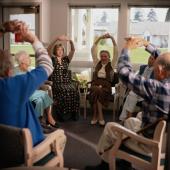Tango Classes Put Parkinson's Patients a Step Ahead
Findings suggest spins, turns of the passionate dance improve mobility, balance.
|
E-mail this article
Subscribe to news
Printer friendly version
|

(SOURCE: Washington University in St. Louis, news release, January 2008)
WEDNESDAY, Feb. 13 (HealthDay News) -- Not only is the tango a dance of romance and passion, it also helps improve balance and mobility in people with Parkinson's disease, a new study suggests.
Researchers at the Washington University in St. Louis medical school compared the effects of Argentine tango lessons and exercise classes on the functional mobility of 19 Parkinson's patients. The patients were randomly assigned to do 20 one-hour tango classes or group strength and exercise sessions designed for Parkinson's patients and the elderly.
All the patients were assessed prior to the start of these activities and after they completed the sessions. The dance classes included stretching, balance exercises, tango-style walking, footwork patterns, experimenting of timing of steps, and dance with and without a partner. The exercise classes included 40 minutes of seated exercise, followed by standing exercises supported by a chair, core strengthening and stretching.
By the end of the sessions, both groups showed significant improvements in standard tests designed to measure mobility. People in the tango group showed more improvement in balance than those in the exercise group.
"Given these preliminary results, we think tango is feasible for individuals with Parkinson's disease and may be an appropriate and effective form of group exercise for individuals with Parkinson's disease," researcher Gammon M. Earhart, an assistant professor of physical therapy, said in a prepared statement.
"Although some participants were initially skeptical because they hadn't danced in years or thought they couldn't because of the disease, this study shows that dance can improve functional mobility," Earhart said.
While dance in general may benefit people with Parkinson's, several aspects of tango movement may be especially helpful to these patients, including dynamic balance, turning, initiation of movement, moving at different speeds, and walking backward.
"This type of therapy looks to be superior than what is currently offered," researcher Madeline E. Hackney, a predoctoral trainee in movement science, said in a prepared statement. "The quality of life improved in these patients because of the social aspect of dancing."
The study was published in the Journal of Neurologic Physical Therapy.
Further studies with larger groups of patients are needed to confirm these preliminary findings, the researchers said.
More information
The National Parkinson Foundation has more about Parkinson's disease treatment options. 
Copyright © 2008 ScoutNews, LLC. All rights reserved. 
HealthDayNews articles are derived from various sources and do not reflect federal policy. healthfinder.gov does not endorse opinions, products, or services that may appear in news stories. For more information on health topics in the news, visit the healthfinder.gov health library.